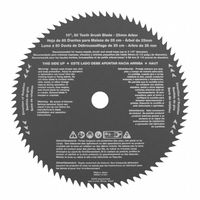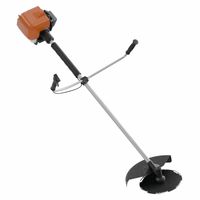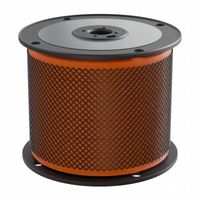Call +(254) 703 030 000 / 751 483 999 / 721 704 777
- Home
- Outdoor Equipment
- Outdoor Power Equipment
- String Trimmers Brush Cutters Edgers
.....Read More
Frequently Asked Questions
What is the difference between a string trimmer and a brush cutter?
A string trimmer and a brush cutter are both garden tools used for cutting grass and vegetation, but they differ in design, functionality, and application.
A string trimmer, often called a weed eater or weed whacker, uses a flexible monofilament line for cutting. It is primarily designed for trimming grass and light vegetation around obstacles, edges, and in areas a lawnmower can't reach. String trimmers are lightweight, easy to maneuver, and typically powered by electricity (corded or battery) or small gas engines. They are ideal for regular lawn maintenance and are best suited for residential use.
In contrast, a brush cutter is a more robust and versatile tool designed for heavier-duty tasks. It can handle thicker vegetation, such as tall grass, weeds, brush, and even small trees. Brush cutters are equipped with a metal blade instead of a string, allowing them to cut through tougher materials. They are generally more powerful, often featuring larger gas engines, and are built to withstand more demanding conditions. Brush cutters are suitable for both residential and commercial use, especially in areas with dense undergrowth or overgrown land.
In summary, the main differences lie in their cutting mechanisms (string vs. blade), power and durability, and intended use. String trimmers are best for light trimming and edging, while brush cutters are designed for heavy-duty clearing and cutting.
How do I choose the right string trimmer for my yard?
To choose the right string trimmer for your yard, consider the following factors:
1. **Yard Size and Terrain**: For small to medium yards, a corded electric or battery-powered trimmer is sufficient. For larger areas or uneven terrain, a gas-powered trimmer offers more power and mobility.
2. **Power Source**:
- **Gas-Powered**: Offers high power and mobility, ideal for large yards. Requires fuel and regular maintenance.
- **Corded Electric**: Lightweight and easy to use, suitable for small yards with access to power outlets.
- **Battery-Powered**: Offers mobility without the noise and emissions of gas models. Check battery life and charging time.
3. **Cutting Width**: A wider cutting width covers more area quickly, ideal for large spaces. Smaller widths offer precision for detailed work.
4. **Weight and Ergonomics**: Choose a model that is comfortable to handle. Adjustable handles and shoulder straps can reduce fatigue.
5. **Shaft Type**:
- **Straight Shaft**: Offers longer reach, suitable for under bushes and hard-to-reach areas.
- **Curved Shaft**: Easier to maneuver and control, ideal for lighter tasks.
6. **Features**:
- **Automatic Feed**: Automatically advances the line, reducing manual adjustments.
- **Convertible Head**: Allows switching between trimming and edging.
- **Variable Speed Control**: Offers flexibility for different tasks.
7. **Budget**: Determine your budget and compare models within that range. Consider long-term costs like maintenance and replacement parts.
8. **Brand and Reviews**: Research brands known for reliability and read customer reviews for real-world performance insights.
By evaluating these factors, you can select a string trimmer that meets your yard's specific needs and your personal preferences.
What type of trimmer line should I use for my string trimmer?
The type of trimmer line you should use for your string trimmer depends on several factors, including the type of vegetation you are cutting, the power of your trimmer, and the specific model of your trimmer. Here are some guidelines:
1. **Material**: Most trimmer lines are made from nylon, but there are variations like reinforced nylon or copolymer blends for added durability. For heavy-duty tasks, consider lines with added materials like aluminum or Kevlar.
2. **Shape**:
- **Round**: Best for light to medium trimming tasks. It is durable and less likely to break.
- **Twisted**: Offers more cutting power and is quieter, suitable for medium to heavy tasks.
- **Square/Star**: Provides sharp edges for cutting through thick grass and weeds, ideal for heavy-duty tasks.
- **Serrated**: Designed for tough, dense vegetation, offering a saw-like cutting action.
3. **Diameter**:
- **Light Work (0.065" - 0.080")**: Suitable for small electric trimmers and light grass trimming.
- **Medium Work (0.085" - 0.105")**: Ideal for larger yards with thicker grass and weeds.
- **Heavy Work (0.110" and above)**: Best for professional-grade trimmers and heavy brush cutting.
4. **Compatibility**: Always check your trimmer’s manual for recommended line types and sizes. Using the wrong line can damage the trimmer or reduce its efficiency.
5. **Environment**: Consider biodegradable lines if you are environmentally conscious, as they reduce plastic waste.
By considering these factors, you can select the appropriate trimmer line that will provide optimal performance and longevity for your specific trimming needs.
How do I maintain and store my string trimmer or brush cutter?
To maintain and store your string trimmer or brush cutter, follow these steps:
1. **Cleaning**: After each use, clean the trimmer thoroughly. Remove grass clippings, dirt, and debris from the cutting head, shaft, and air vents using a brush or cloth.
2. **Inspect and Replace Parts**: Regularly check the trimmer line for wear and replace it if necessary. Inspect the cutting head, guard, and handle for damage. Tighten any loose screws or bolts.
3. **Fuel System**: For gas-powered models, use fresh fuel and the correct oil mix. Drain the fuel tank before long-term storage to prevent gum deposits. Run the engine until it stops to clear the carburetor.
4. **Air Filter**: Clean or replace the air filter regularly to ensure optimal engine performance. A clogged filter can reduce efficiency and increase fuel consumption.
5. **Spark Plug**: Check the spark plug for wear and carbon buildup. Clean or replace it annually or as needed to ensure easy starting and smooth operation.
6. **Lubrication**: Lubricate the drive shaft and other moving parts according to the manufacturer's instructions to prevent rust and ensure smooth operation.
7. **Blade Maintenance**: For brush cutters, sharpen the blade regularly and check for damage. Replace the blade if it is dull or chipped.
8. **Storage**: Store the trimmer in a dry, cool place away from direct sunlight. Hang it on a wall or place it on a shelf to prevent damage. For electric models, ensure the cord is coiled neatly and not under tension.
9. **Battery Care**: For battery-powered models, charge the battery fully before storage and remove it from the trimmer. Store the battery in a cool, dry place.
10. **Regular Servicing**: Follow the manufacturer's maintenance schedule and have the trimmer serviced by a professional if needed.
Can I use a string trimmer for edging?
Yes, you can use a string trimmer for edging, but it requires some technique and practice to achieve clean, precise edges. A string trimmer, also known as a weed eater or weed whacker, is primarily designed for trimming grass and weeds in areas that are difficult to reach with a lawnmower. However, it can be adapted for edging by following these steps:
1. **Positioning**: Hold the trimmer so that the string is vertical to the ground. This orientation allows the string to cut along the edge of the lawn, creating a defined line between the grass and the adjacent surface, such as a sidewalk or driveway.
2. **Control**: Maintain a steady hand and move the trimmer slowly along the edge. Consistent speed and movement help in achieving a straight line. It may be helpful to use a guide, such as the edge of the pavement, to keep your line straight.
3. **Depth**: Be mindful of the depth of the cut. The string should just skim the surface to remove overhanging grass without digging into the soil. Adjust the angle and height of the trimmer as needed to maintain the desired depth.
4. **Safety**: Wear protective gear, including safety glasses and long pants, to protect against flying debris. Ensure that the area is clear of obstacles and bystanders.
5. **Practice**: Achieving a professional-looking edge with a string trimmer may take some practice. Start slowly and gradually increase your speed as you become more comfortable with the technique.
While a string trimmer can be used for edging, dedicated edging tools or attachments may provide more precise results with less effort. However, for occasional use or small areas, a string trimmer can be an effective and versatile tool for both trimming and edging tasks.
What safety precautions should I take when using a brush cutter?
When using a brush cutter, prioritize safety by following these precautions:
1. **Personal Protective Equipment (PPE):** Wear safety goggles or a face shield to protect your eyes from debris. Use ear protection like earplugs or earmuffs to guard against noise. Wear gloves to protect your hands and ensure a firm grip. Use sturdy, non-slip boots and long pants to protect your legs and feet.
2. **Inspect Equipment:** Before use, check the brush cutter for any damage or loose parts. Ensure the blade or string is in good condition and securely attached. Verify that all safety guards are in place and functioning.
3. **Fuel Safety:** If using a gas-powered brush cutter, refuel in a well-ventilated area, away from open flames or sparks. Turn off the engine and allow it to cool before refueling to prevent fire hazards.
4. **Clear the Area:** Remove any obstacles like rocks, branches, or debris from the work area to prevent them from becoming projectiles. Ensure bystanders, especially children and pets, are at a safe distance.
5. **Proper Handling:** Maintain a firm grip on the brush cutter with both hands. Keep a balanced stance and be aware of your footing, especially on uneven or slippery terrain.
6. **Operational Awareness:** Be mindful of the cutter's kickback zone and avoid cutting above shoulder height. Do not overreach or use the cutter in awkward positions.
7. **Emergency Preparedness:** Know how to quickly shut off the brush cutter in case of an emergency. Keep a first aid kit and a phone nearby for emergencies.
8. **Training and Manuals:** Familiarize yourself with the user manual and understand the specific controls and features of your brush cutter. Consider taking a safety course if you're inexperienced.
By adhering to these precautions, you can significantly reduce the risk of accidents and injuries while using a brush cutter.
How do I replace the trimmer line on my string trimmer?
1. **Safety First**: Ensure the trimmer is turned off and unplugged or the battery is removed to prevent accidental starting.
2. **Access the Spool**: Locate the trimmer head. Depending on the model, you may need to press tabs, unscrew a cap, or remove a cover to access the spool.
3. **Remove the Spool**: Take out the spool from the trimmer head. Note the direction of the arrows on the spool indicating the winding direction.
4. **Prepare the Line**: Cut a length of trimmer line, typically 10-25 feet, depending on the model. Check the user manual for the recommended line diameter.
5. **Wind the Line**: Insert one end of the line into the anchor hole or slot on the spool. Wind the line tightly and evenly in the direction indicated by the arrows. Avoid overlapping to prevent tangling.
6. **Secure the Line**: Once wound, secure the line by inserting the ends into the holding slots on the spool. Leave about 6 inches of line free on each end.
7. **Reinstall the Spool**: Place the spool back into the trimmer head. Thread the free ends of the line through the eyelets or holes on the trimmer head.
8. **Secure the Trimmer Head**: Reattach the cap or cover, ensuring it is tightly secured. Pull the line ends to release them from the holding slots.
9. **Test the Trimmer**: Reconnect the power source. Turn on the trimmer to ensure the line feeds correctly and the trimmer operates smoothly.
10. **Adjust Line Length**: If necessary, tap the trimmer head on the ground to advance the line to the correct length. Trim any excess line if needed.





